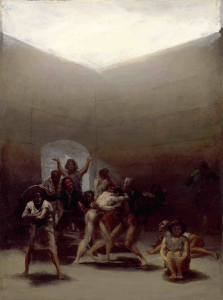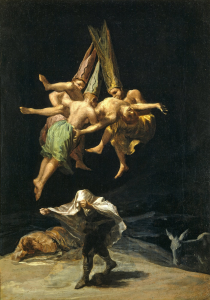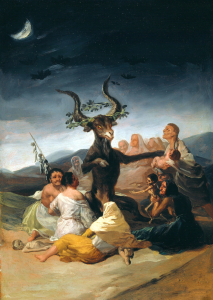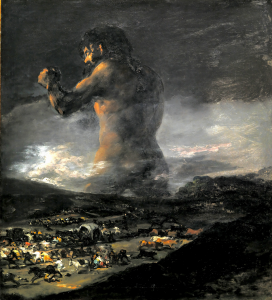Saturno devorando a su hijo
The general structure of the work
Relationship of movements
The third is the axis, the form is based on a false mirror where the (original) elements are presented by opposite movement forming a false palindrome.
The elements thematic of the movements are related, the elements of the first movement reappear in the fifth movement and the elements of the second movement are related in the fourth.
I-V
II-IV
Use of rhythmics
The predominant rhythm in the first movement is based on a four-beat measure and in the second movement is based on a three-beat measure. These features are even more present in the fourth and the fifth movement.
In the third movement (who does the axis of the work) the primary theme is structured over the ternary measure plus a quaternary measure 3/4 + 4/4 and the secondary theme over a quaternary measure plus a ternary measure 4/4 + 3/4.
Program notes
First Movement

Corral de Locos
The first movement starts describing the characters of the painting "Corral de Locos". The string represents the sick and the clarinet the keeper.
In the first section, the language used is formed on the octatonic scale. The second section represents the feelings of the participants, the feelings of the protagonists are described. Nostalgia, longing for freedom, longing, etc.
Second Movement
The occult has always been present, like those who dont want to see, or those who simply dont want to hear and of course, their own ignorance couldnt be absent

Sometimes I like to be helped by famous sentences to find inspiration.
For the first section, I have related the painting of goya with the sentence of Frankling D. Roosevelt We have nothing to fear except fear itself
The theme is created over a fourth augmented interval (devil symbol) and is performed by the clarinet and the cello in contrary motion.
As if it were a procession, the witches with their hoods inspire enough confidence so that everyone is calm.
For the second section, I helped myself with the sentence of William Shakespeare There is no darkness but ignorance.
This secondary theme represents ignorance through dance, it represents the fun in front of reality.
Third Movement
Aquelarre
 For the movement "Aquelarre" I have decided to confront the idea of the goat dictating the fate of those around him (Theme a) with the idea of people as mere puppeteers (Theme b). For this theme b, I use the clarinet in its most burlesque register.
For the movement "Aquelarre" I have decided to confront the idea of the goat dictating the fate of those around him (Theme a) with the idea of people as mere puppeteers (Theme b). For this theme b, I use the clarinet in its most burlesque register.
Although the form of the movement is a sonata form, the opposite order in the inputs of the different themes makes the sonata form as such only the common thread of the different sections.
Fourth Movement
El Coloso
 To each scenario possible it is worse, doesnt matter if Goya thought in the barbarism of Napoleon or in the incompetence of Fernando VII. Every situation drives into the same scenario. Maybe Goya
To each scenario possible it is worse, doesnt matter if Goya thought in the barbarism of Napoleon or in the incompetence of Fernando VII. Every situation drives into the same scenario. Maybe Goya
 This product was created by a member of ArrangeMe, Hal Leonard's global self-publishing community of independent composers, arrangers, and songwriters. ArrangeMe allows for the publication of unique arrangements of both popular titles and original compositions from a wide variety of voices and backgrounds.
This product was created by a member of ArrangeMe, Hal Leonard's global self-publishing community of independent composers, arrangers, and songwriters. ArrangeMe allows for the publication of unique arrangements of both popular titles and original compositions from a wide variety of voices and backgrounds.